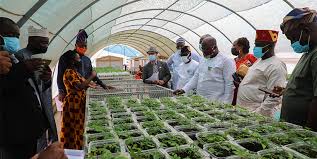Agricultural policies are guidelines and regulations established by governments to manage and support the agricultural sector. These policies shape how food is produced, processed, and distributed. They aim to enhance productivity, ensure food safety, and protect the environment.
Importance of Agricultural Regulations
Agricultural regulations play a vital role in the functioning of the agricultural sector. Here are some key reasons why they are important:
1. Food Security: Regulations help ensure a stable food supply by supporting farmers and managing food production.
2. Environmental Protection: Policies promote sustainable farming practices that protect natural resources and minimize environmental degradation.
3. Economic Stability: Agricultural policies help stabilize prices and income for farmers, promoting economic growth in rural areas.
4. Consumer Protection: Regulations ensure the safety and quality of food products, safeguarding public health.
5. Rural Development: Policies can stimulate rural development by investing in infrastructure, education, and technology.
Historical Overview of Agricultural Policies

Agricultural policies have evolved significantly over time. Here’s a brief historical overview:
1. Early Policies: In the early days, agricultural policies focused on land distribution and support for small farmers to increase food production.
2. Green Revolution: The 1960s and 1970s saw the introduction of high-yield varieties and chemical fertilizers, leading to significant increases in crop production, supported by government policies.
3. Shift to Sustainability: In recent decades, there has been a shift towards sustainable agriculture, with policies promoting environmental conservation and sustainable practices.
4. Globalization: As trade has increased, agricultural policies have adapted to ensure competitiveness in the global market.
5. Climate Change Response: In response to climate change, modern policies are focusing on resilience and adaptation strategies for farmers.
Key Objectives of Agricultural Policies
Agricultural policies aim to achieve several key objectives:
1. Increase Agricultural Productivity: Policies are designed to boost production efficiency and enhance food availability.
2. Ensure Fair Income for Farmers: Ensuring that farmers receive fair prices for their products is a crucial goal of agricultural policies.
3. Promote Sustainable Practices: Policies encourage practices that protect the environment and promote sustainable resource use.
4. Support Research and Development: Investing in agricultural research helps develop new technologies and practices that improve farming.
5. Improve Food Safety and Quality: Policies aim to establish standards that ensure food safety and quality for consumers.
Types of Agricultural Policies
There are several types of agricultural policies, each serving different purposes:
1. Price Support Policies: These policies stabilize prices for agricultural products, ensuring farmers receive a fair income.
2. Subsidy Programs: Governments provide financial assistance to farmers to lower production costs and encourage certain crops.
3. Trade Policies: These policies govern imports and exports of agricultural products, promoting competitiveness in international markets.
4. Environmental Regulations: Policies aimed at promoting sustainable practices and protecting natural resources.
5. Research and Extension Services: These policies support agricultural research and provide education and resources to farmers, helping them adopt new technologies and practices.
Role of Government in Agricultural Regulation
The government is responsible for creating and enforcing agricultural regulations that impact various aspects of the agricultural sector. Here are some key functions of government in agricultural regulation:
1. Policy Formulation: Governments develop policies that outline the direction for agricultural practices, production methods, and food safety standards.
2. Safety Standards: Regulations ensure that food products meet safety and quality standards to protect public health.
3. Financial Assistance: Governments provide financial support and subsidies to help farmers maintain their livelihoods and stabilize the agricultural economy.
4. Resource Management: Regulations guide the sustainable use of land, water, and other natural resources to protect the environment.
5. Research and Development Support: Governments fund agricultural research to encourage innovation and improve farming practices.
Read Also: 14 Medicinal Health Benefits of Ghost Pepper (Capsicum Chinese)
International Agricultural Agreements

International agricultural agreements play a significant role in regulating trade and promoting cooperation among countries. Here are some key aspects:
1. Trade Agreements: These agreements, such as the World Trade Organization (WTO) agreements, establish rules for international agricultural trade, reducing tariffs and promoting fair competition.
2. Food Security Initiatives: Agreements often focus on ensuring food security by promoting agricultural development and cooperation among nations.
3. Environmental Commitments: International agreements may include commitments to sustainable agricultural practices and environmental protection.
4. Capacity Building: These agreements often provide support to developing countries to enhance their agricultural systems and improve food production.
5. Market Access: International agreements help improve market access for farmers, allowing them to sell their products globally.
Environmental Regulations in Agriculture
Environmental regulations are essential for promoting sustainable agricultural practices and protecting natural resources. Key elements include:
1. Conservation Practices: Regulations encourage farmers to adopt practices that conserve soil, water, and biodiversity.
2. Pollution Control: Policies limit the use of harmful chemicals and promote responsible waste management to protect the environment.
3. Climate Change Mitigation: Environmental regulations aim to reduce agriculture’s carbon footprint and promote practices that enhance resilience to climate change.
4. Resource Management: Regulations ensure the sustainable use of natural resources, including water and land, to promote long-term agricultural sustainability.
5. Incentives for Sustainable Practices: Governments may provide incentives for farmers who adopt environmentally friendly practices, such as organic farming or conservation tillage.
Read Also: How often you need to Change Water in your Fish Farm
Trade Policies Affecting Agriculture

Trade policies significantly influence the agricultural sector by determining how products are traded between countries. Key aspects include:
1. Tariffs and Quotas: Governments impose tariffs and quotas on agricultural imports and exports, affecting prices and market access for farmers.
2. Export Subsidies: Some governments provide subsidies to encourage exports, giving domestic farmers a competitive edge in international markets.
3. Import Regulations: Countries may establish regulations on imported agricultural products to protect domestic farmers from foreign competition.
4. Trade Negotiations: Governments engage in negotiations to create favorable trade conditions for their agricultural products.
5. Impact on Local Markets: Trade policies can influence local market prices, affecting farmers’ income and access to resources.
Subsidies and Support Programs for Farmers
Subsidies and support programs are vital for ensuring the economic stability of farmers. Key features include:
1. Direct Payments: Governments provide direct payments to farmers to help stabilize their income and offset production costs.
2. Crop Insurance: Support programs offer crop insurance to protect farmers from losses due to adverse weather or market fluctuations.
3. Technical Assistance: Governments provide technical support and training programs to help farmers adopt best practices and improve productivity.
4. Research Funding: Funding for agricultural research helps develop new technologies and practices that benefit farmers.
5. Rural Development Initiatives: Support programs often include initiatives aimed at improving infrastructure and services in rural areas, promoting overall agricultural development.
Do you have any questions, suggestions, or contributions? If so, please feel free to use the comment box below to share your thoughts. We also encourage you to kindly share this information with others who might benefit from it. Since we can’t reach everyone at once, we truly appreciate your help in spreading the word. Thank you so much for your support and for sharing!
Read Also: The Effect of Heat Stress on Animal Productivity

